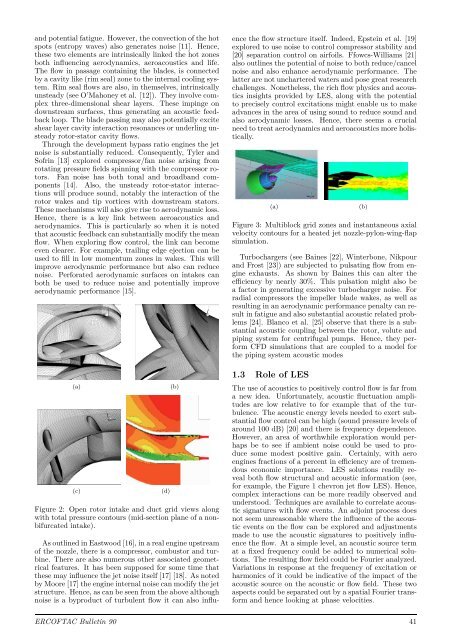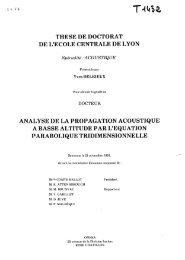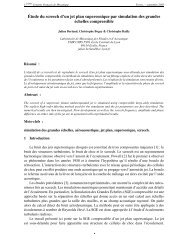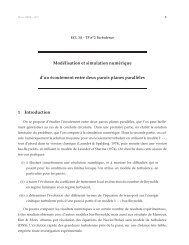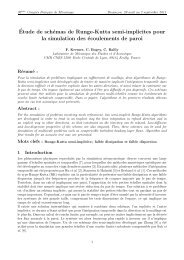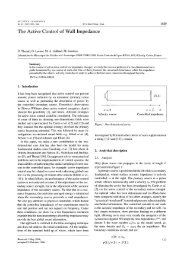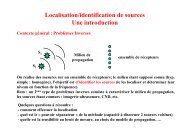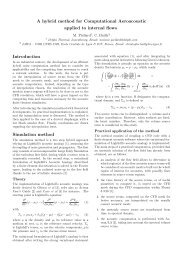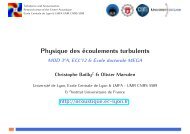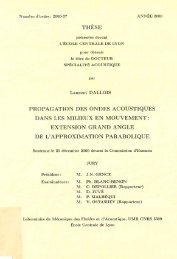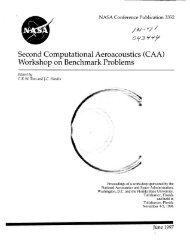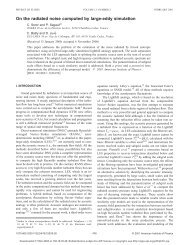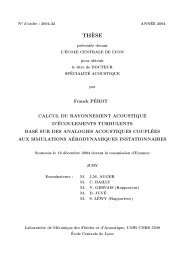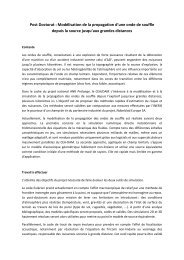ERCOFTAC Bulletin - Centre Acoustique
ERCOFTAC Bulletin - Centre Acoustique
ERCOFTAC Bulletin - Centre Acoustique
You also want an ePaper? Increase the reach of your titles
YUMPU automatically turns print PDFs into web optimized ePapers that Google loves.
and potential fatigue. However, the convection of the hot<br />
spots (entropy waves) also generates noise [11]. Hence,<br />
these two elements are intrinsically linked the hot zones<br />
both influencing aerodynamics, aeroacoustics and life.<br />
The flow in passage containing the blades, is connected<br />
by a cavity like (rim seal) zone to the internal cooling system.<br />
Rim seal flows are also, in themselves, intrinsically<br />
unsteady (see O’Mahoney et al. [12]). They involve complex<br />
three-dimensional shear layers. These impinge on<br />
downstream surfaces, thus generating an acoustic feedback<br />
loop. The blade passing may also potentially excite<br />
shear layer cavity interaction resonances or underling unsteady<br />
rotor-stator cavity flows.<br />
Through the development bypass ratio engines the jet<br />
noise is substantially reduced. Consequently, Tyler and<br />
Sofrin [13] explored compressor/fan noise arising from<br />
rotating pressure fields spinning with the compressor rotors.<br />
Fan noise has both tonal and broadband components<br />
[14]. Also, the unsteady rotor-stator interactions<br />
will produce sound, notably the interaction of the<br />
rotor wakes and tip vortices with downstream stators.<br />
These mechanisms will also give rise to aerodynamic loss.<br />
Hence, there is a key link between aeroacoustics and<br />
aerodynamics. This is particularly so when it is noted<br />
that acoustic feedback can substantially modify the mean<br />
flow. When exploring flow control, the link can become<br />
even clearer. For example, trailing edge ejection can be<br />
used to fill in low momentum zones in wakes. This will<br />
improve aerodynamic performance but also can reduce<br />
noise. Perforated aerodynamic surfaces on intakes can<br />
both be used to reduce noise and potentially improve<br />
aerodynamic performance [15].<br />
(a) (b)<br />
(c) (d)<br />
Figure 2: Open rotor intake and duct grid views along<br />
with total pressure contours (mid-section plane of a nonbifurcated<br />
intake).<br />
As outlined in Eastwood [16], in a real engine upstream<br />
of the nozzle, there is a compressor, combustor and turbine.<br />
There are also numerous other associated geometrical<br />
features. It has been supposed for some time that<br />
these may influence the jet noise itself [17] [18]. As noted<br />
by Moore [17] the engine internal noise can modify the jet<br />
structure. Hence, as can be seen from the above although<br />
noise is a byproduct of turbulent flow it can also influ-<br />
ence the flow structure itself. Indeed, Epstein et al. [19]<br />
explored to use noise to control compressor stability and<br />
[20] separation control on airfoils. Ffowcs-Williams [21]<br />
also outlines the potential of noise to both reduce/cancel<br />
noise and also enhance aerodynamic performance. The<br />
latter are not unchartered waters and pose great research<br />
challenges. Nonetheless, the rich flow physics and acoustics<br />
insights provided by LES, along with the potential<br />
to precisely control excitations might enable us to make<br />
advances in the area of using sound to reduce sound and<br />
also aerodynamic losses. Hence, there seems a crucial<br />
need to treat aerodynamics and aeroacoustics more holistically.<br />
(a) (b)<br />
Figure 3: Multiblock grid zones and instantaneous axial<br />
velocity contours for a heated jet nozzle-pylon-wing-flap<br />
simulation.<br />
Turbochargers (see Baines [22], Winterbone, Nikpour<br />
and Frost [23]) are subjected to pulsating flow from engine<br />
exhausts. As shown by Baines this can alter the<br />
efficiency by nearly 30%. This pulsation might also be<br />
a factor in generating excessive turbocharger noise. For<br />
radial compressors the impeller blade wakes, as well as<br />
resulting in an aerodynamic performance penalty can result<br />
in fatigue and also substantial acoustic related problems<br />
[24]. Blanco et al. [25] observe that there is a substantial<br />
acoustic coupling between the rotor, volute and<br />
piping system for centrifugal pumps. Hence, they perform<br />
CFD simulations that are coupled to a model for<br />
the piping system acoustic modes<br />
1.3 Role of LES<br />
The use of acoustics to positively control flow is far from<br />
a new idea. Unfortunately, acoustic fluctuation amplitudes<br />
are low relative to for example that of the turbulence.<br />
The acoustic energy levels needed to exert substantial<br />
flow control can be high (sound pressure levels of<br />
around 100 dB) [20] and there is frequency dependence.<br />
However, an area of worthwhile exploration would perhaps<br />
be to see if ambient noise could be used to produce<br />
some modest positive gain. Certainly, with aero<br />
engines fractions of a percent in efficiency are of tremendous<br />
economic importance. LES solutions readily reveal<br />
both flow structural and acoustic information (see,<br />
for example, the Figure 1 chevron jet flow LES). Hence,<br />
complex interactions can be more readily observed and<br />
understood. Techniques are available to correlate acoustic<br />
signatures with flow events. An adjoint process does<br />
not seem unreasonable where the influence of the acoustic<br />
events on the flow can be explored and adjustments<br />
made to use the acoustic signatures to positively influence<br />
the flow. At a simple level, an acoustic source term<br />
at a fixed frequency could be added to numerical solutions.<br />
The resulting flow field could be Fourier analyzed.<br />
Variations in response at the frequency of excitation or<br />
harmonics of it could be indicative of the impact of the<br />
acoustic source on the acoustic or flow field. These two<br />
aspects could be separated out by a spatial Fourier transform<br />
and hence looking at phase velocities.<br />
<strong>ERCOFTAC</strong> <strong>Bulletin</strong> 90 41


